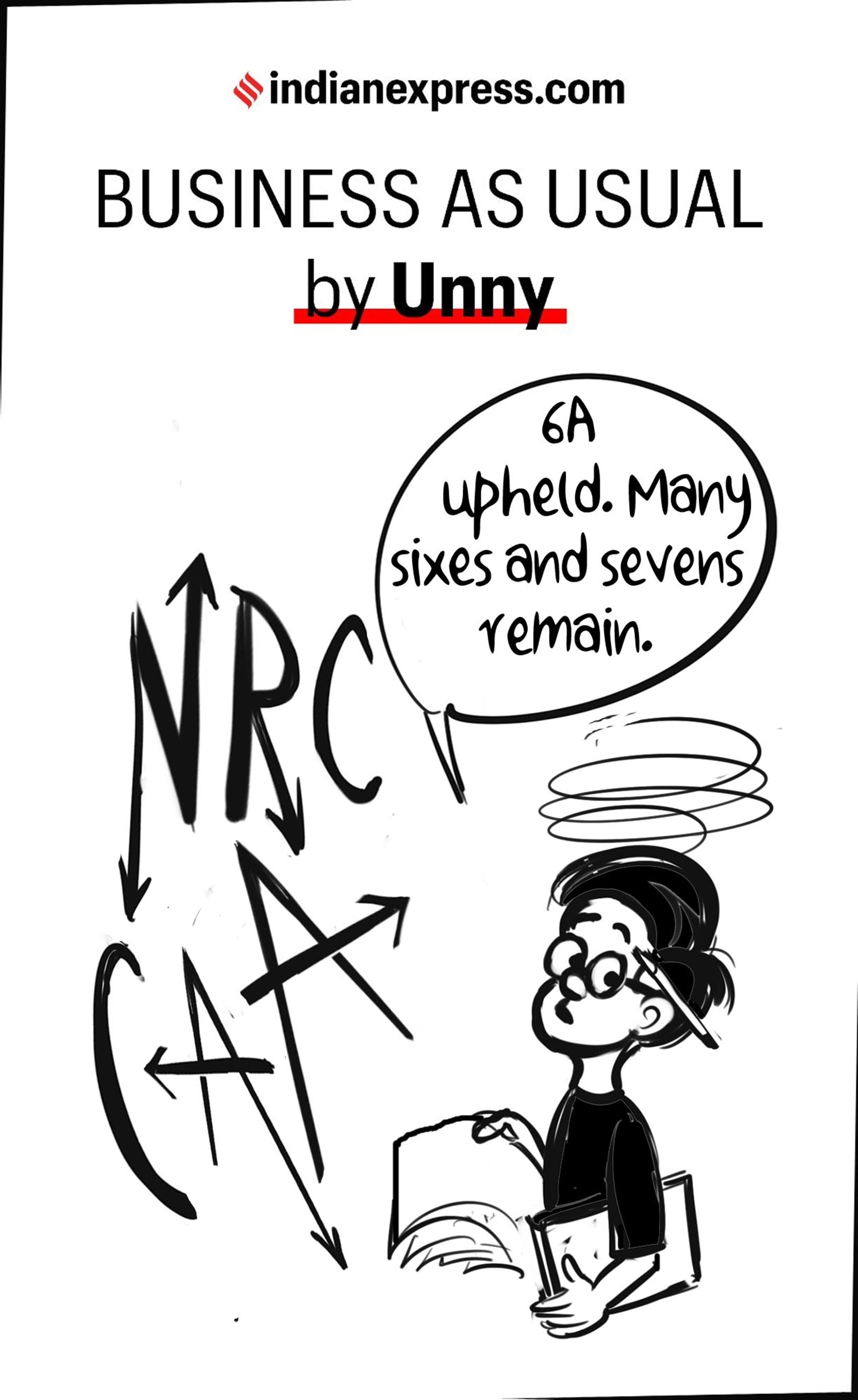Vibha B Madhava is a sub-editor at the news desk for IndianExpress.com. She is interested in writing about gender, culture and politics of ableism. Having specialised in digital journalism, she is keen to explore various forms of interactive, multimedia storytelling. Apart from that, she also likes to experiment with social media. Qualification, Degrees/other achievements: Bachelor's degree in Media and Communication from Manipal Institute of Communication, Manipal Academy of Higher Education. PG Diploma in Integrated Multimedia Journalism from Asian College of Journalism, Chennai. With The Indian Express, this is Vibha's first stint in pursuing journalism in a full-time capacity. Previous internship experience: Deccan Herald, Bengaluru; The News Minute, Bengaluru; The Mojo Story; Radio Indigo 91.9 and Fever FM 94.3 (Hyderabad) You can find her on Twitter as @VibhaBMadhava , on LinkedIn (Vibha B Madhava), or write to her at vibha.madhava@indianexpress.com. ... Read More
Daily Briefing: Who is a citizen in India?
In today's edition: Nawaz Sharif on Jaishankar’s Pakistan visit; Hamas chief Yahya Sinwar killed; India all out for 46; and more
 Top headlines - October 18
Top headlines - October 18Good morning!
Starting July 2025, Jawaharlal Nehru University (JNU) may have a ‘Centre of Excellence’ named after Chhatrapati Shivaji Maharaj. The aim is to draw lessons from his era to understand the “concept of Akhand Bharat” and his “struggle for Hindavi Swaraj”, The Indian Express has learnt.
Under its School of International Studies, six proposed courses are in the works to offer Shivaji’s “leadership, strategic, administrative and diplomatic attributes… which contributed to developing a new Bharat”. Some of those classes are going to be thought-provoking, for sure: ‘Maratha Grand Strategy’, ‘Statesmanship and Statecraft of Shivaji Maharaj and After’ and the likes!
🚨Big Story
In a landmark verdict, the Supreme Court on Thursday upheld the constitutional validity of Section 6A of the Citizenship Act, 1955 – the unique process for granting citizenship to migrants who entered Assam until March 24, 1971.
What does Section 6A provide?
It codified the political consensus of the 1985 Assam Accord, a key element of which was determining who is a “foreigner” in the state.
The tripartite Accord between the central and Assam governments, and the leaders of the Assam Movement introduced a cut-off date – January 1, 1966 – for the detection of “foreigners” and their deletion from electoral rolls. It also provided a process for the grant of citizenship to those who arrived in Assam after that date, i.e., upto March 24, 1971.
Why was Section 6A challenged?
The petitioner claimed that the cut-off date provided in Section 6A is discriminatory and violates the right to equality (Article 14 of the Constitution) as it provides a different standard for citizenship for immigrants entering Assam than the rest of India — which is July 1948.
More on the verdict: “Our reading of the Constitution and precedents is that fraternity requires people of different backgrounds and social circumstances to ‘live and let live’.”
Fraternity as a factor: Pushing for an inclusive view on who is a citizen, the top court’s ruling by a 4-1 majority also held that Parliament has the power to grant citizenship under different conditions so long as the differentiation is reasonable.
The Bench led by Chief Justice DY Chandrachud highlighted that the migrant situation in Assam was unique in comparison to the rest of India. So it was justified to create a law to specifically address it and doing so would not violate the right to equality under Article 14 of the Constitution.
1 voice of dissent: Justice JB Pardiwala penned a dissent. He held that the provision was “invalid with prospective effect”. He said it does not prescribe a time limit for detecting foreigners and determining whether they were citizens. Calling the Assam Accord a “one-time political settlement,” he said the “open-ended nature” of Section 6A has, with the passage of time, become “more prone to abuse”, promoting further immigration into Assam.
A shot in the arm: The Congress welcomed the SC ruling which did not turn the clock back to 1951 as the cut-off year. Party insiders say it could help their front against Assam Chief Minister Himanta Biswa Sarma’s key element – his “cocktail of Hindutva and Assamese identity politics”. The issue of undocumented immigration from Bangladesh has also been part of Sarma’s way of sharpening the plank after the Lok Sabha elections.
⚡Only in Express
“Cricketers have helped build bridges between the two sides earlier too.”
External Affairs Minister S Jaishankar’s visit to Pakistan this week to attend a meeting of the Shanghai Cooperation Organisation (SCO) appears to have set the stage for ending the prolonged chill in bilateral relations.
If signals from Islamabad remain steady, the Indian cricket team will travel to Pakistan for the ICC Champions Trophy in February next year – after 16 long years of the sport being entangled in the complexities of India-Pakistan politics. While the countries and their cricket have changed beyond recognition, Sandeep Dwivedi writes on how the tournament could see an accurate calibration of the popularity of Indian cricketers in Pakistan, as also the depth of that country’s cricketing distress.
📰From the Front Page
‘Good opening’: While on the subject of Jaishankar’s Islamabad visit, former Pakistan Prime Minister Nawaz Sharif also pitched for restoration of India-Pakistan cricket ties. More importantly, he called it a “good beginning”, adding that the two countries should “live like good neighbours” and “look to the future”.
Middle East Crisis deepens: The Israel Defence Forces announced yesterday evening that it had eliminated Hamas chief Yahya Sinwar in a targeted ground operation in Rafah in southern Gaza. Sinwar was among the three Hamas militants killed in the operation, with his identity being confirmed with the help of a DNA test using Sinwar’s sample from his time in imprisonment in Israel. Israel has long viewed Sinwar as the mastermind of the October 7 attack, and referred to him as “a dead man walking”.
📌Must Read
A gangster amid India-Canada row: The back-and-forth between India and Canada continues with the latest being on the latter’s allegations of links between Indian government “agents” and “organised crime elements” — the Lawrence Bishnoi gang in particular. New Delhi, in a strong rebuttal to Ottawa’s allegations, said that they had been requesting the Justin Trudeau government to arrest members of the Bishnoi gang, but there has been no action so far.
Tackling a menace: With over 30 flights of major Indian airlines hit by hoax bomb threats in the last week, the Ministry of Civil Aviation is exploring ways to make regulations more stringent to enable harsher punishments for those behind such acts. One of the first measures that is understood to be in the works is inclusion of those behind hoax bomb threats in the no-fly list, which essentially would ban them from flying on Indian carriers’ flights. The government is also studying anti-hoax provisions that are followed in various other countries, which can be incorporated in the regulations in India.
In case you want an in-depth view of what the bomb threats have been all about, tune into our ‘3 Things’ podcast.
👉And Finally…
As India look to bounce back against New Zealand after a harrowing batting performance, a look at what went wrong on Day 2 of the Test at Bengaluru reveals a lot. Yes, the conditions were harsh and yes the tactics backfired but the New Zealand’s exposed various aspects of India’s batting in varying degrees. India’s batsmen failed the technique test. Angled and crooked bats, pokes and prods met the moving ball, some that challenged the principles of geometry. A sturdy defensive shot was rarer than the falcons that usually hover over the arena.
That’s all for today
Until tomorrow
Vibha B Madhava and Rounak Bagchi
 Business As Usual – E P Unny (October 18)
Business As Usual – E P Unny (October 18)






- 01
- 02
- 03
- 04
- 05


























